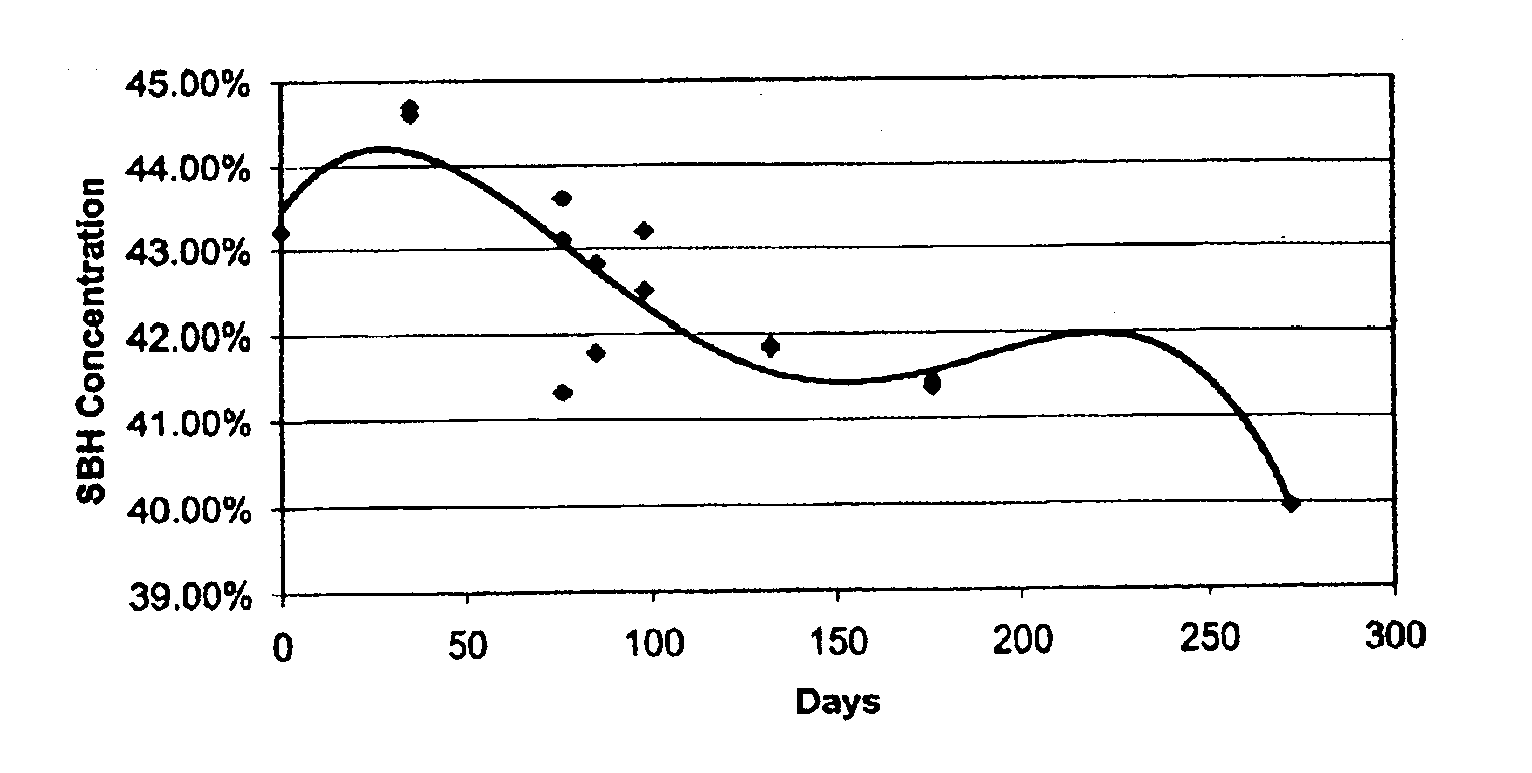Aqueous borohydride compositions
a technology of borohydride composition and borohydride, which is applied in the direction of alkali metal sulfites/sulfates, other chemical processes, explosives, etc., can solve the problems of high ph fuel, high ph fuel, and high flammability of materials, so as to reduce the use of caustic soda, and increase the concentration of alkali metal borohydrid
- Summary
- Abstract
- Description
- Claims
- Application Information
AI Technical Summary
Benefits of technology
Problems solved by technology
Method used
Image
Examples
example 1
Sodium borohydride solution (12% w / w sodium borohydride, 40% w / w sodium hydroxide, and 48% w / w water) and isopropylamine (IPA) are feed into a counter current extraction column in a ratio of approximately two parts by volume of IPA and one part sodium borohydride solution. The sodium borohydride is dissolved into the IPA and flows out the top of the extractor while the sodium hydroxide and water flows out the bottom. The IPA / sodium borohydride solution contains approximately 6% sodium borohydride and only a few tenths of a percent sodium hydroxide. The IPA / sodium borohydride solution is then directed to an evaporator to remove IPA from the solution, and the IPA / sodium borohydride solution is concentrated to a point where the sodium borohydride solution is virtually free of IPA. The concentrated sodium borohydride solution is then sent to a mixing tank. In the mixing tank the concentrated sodium borohydride solution, water and a 12% w / w aqueous sodium borohydride solution are combine...
example 2
Alkaline aqueous sodium borohydride solutions were prepared in the proportions shown in Table A below using sodium hydroxide as the caustic material. The solutions were stored at the temperature shown in Table A, and the decomposition rate of the sodium borohydride was determined by hydrogen evolution. The resulting decomposition rates are also shown in Table A. The results reported in Table A show that a 44% w / w solution of sodium borohydride is stabilized against decomposition by a surprisingly low level of caustic.
TABLE ADecompositionAqueousSolutionTemperatureRate% NaBH4% CausticDeg C.% NaBH4 / hr.12.040.025.00.009.30.025.02.509.30.525.00.3044.00.040.00.0644.00.140.00.0144.00.240.00.0047.00.750.00.0347.01.050.00.0250.00.360.00.1750.00.560.00.1050.00.760.00.03
example 3
Samples of the 44% sodium borohydride solution prepared according to the process of Example 1 are stored at 25 degrees C. for the periods indicated in Table B. The concentration of sodium borohydride in the sample is determined either by the titration method or by evolution of hydrogen, using a modification of the test procedure of Davis, W. D.; Mason, L. S.; Stegeman, G., J. American Chemical Society 1949, 71, 2775; and the results are reported in Table B and graphed in FIG. 1. The results reported in Table B and displayed in FIG. 1 show that the 44% sodium borohydride solution surprisingly retains about 90 percent of its initial activity, even after almost a year of storage.
TABLE BWeight PercentMethodTime ElapsedSodium Borohydride(Titration / Evolution)(Days)43.21%T044.60%T3544.70%T3543.60%T7643.10%T7641.33%E7642.83%E8541.79%E8542.50%E9843.20%E9841.86%E13241.83%E13241.37%E17641.45%E17639.96%E272
PUM
| Property | Measurement | Unit |
|---|---|---|
| mole ratio | aaaaa | aaaaa |
| temperature | aaaaa | aaaaa |
| mass | aaaaa | aaaaa |
Abstract
Description
Claims
Application Information
 Login to View More
Login to View More - R&D
- Intellectual Property
- Life Sciences
- Materials
- Tech Scout
- Unparalleled Data Quality
- Higher Quality Content
- 60% Fewer Hallucinations
Browse by: Latest US Patents, China's latest patents, Technical Efficacy Thesaurus, Application Domain, Technology Topic, Popular Technical Reports.
© 2025 PatSnap. All rights reserved.Legal|Privacy policy|Modern Slavery Act Transparency Statement|Sitemap|About US| Contact US: help@patsnap.com


